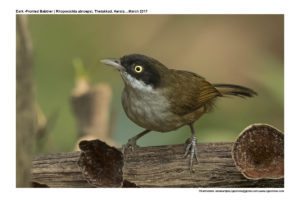
Dark-fronted Babbler Rhopocichla atriceps.
Etymology:
- Rhopocichla :Greek word Rhops-Bush ; kikhle – thrush
- Atriceps : Latin word Atri- Black/dark , Ceps : Head
They belong to the Old-World Babblers
Distribution in India: Resident of Western Ghats.
Description: Size of 12-13 Cm. 13 cm; 16–17 g. It is a compact square-tailed brown-backed babbler with variably dark head, yellowish eye and whitish underparts. The nominate race has head down to moustachial line, cheek and ear-coverts as blackish-brown, upperparts, upperwing and tail are warm olive-brown. The chin, throat and submoustachial area is pure white. The breast, upper flanks and belly are white, tinged grey. The lower flanks, thighs and vent are dull ochrous-buff; iris is pale yellow; upper mandible is dark horn-brown, lower mandible is pale greyish-flesh; legs are pinkish-grey. Both the sexes are similar. The juvenile has black on head side less sharply defined, edges of wings and tail are rustier. The race bourdilloni has crown, nape, lores and cheek as sooty brown, more extensive and richer ochre on lower underparts; race siccata has colour of upperparts extending onto head as far as mid-crown, breast and central belly cleaner white; nigrifrons is richer-toned above.
Habitat: It is found in undergrowth and clearings in forest, secondary growth, overgrown plantations, sholas, thickets near streams, dense and marshy jungle, cardamom cultivation, scrub, reedbeds, and bamboo-jungle and cane brakes in dank ravines. It is found from lowlands to 1800 m.
Food Habits: They eat a variety of insects and worms found in the undergrowth .They often join mixed species foraging flock for better availability of food and protection from predation.
Breeding Habits: They breed in Mar–Jul in India, and in all months (with least activity Jun–Sept) in Srilanka. The nest is a loose dome made of dry bamboo or other leaves, grasses and twigs, lined with black rootlets and grasses, placed above ground in thick shrub, brambles, grass, reeds or weeds. They also build “cock nests”, very loosely and untidily made balls of bamboo leaves, unlined and usually in full view, not used for breeding although up to four birds may roost in them. The breeding nest may be used as a family roost for some time after young fledge. They lay a clutch of 2–3 eggs.